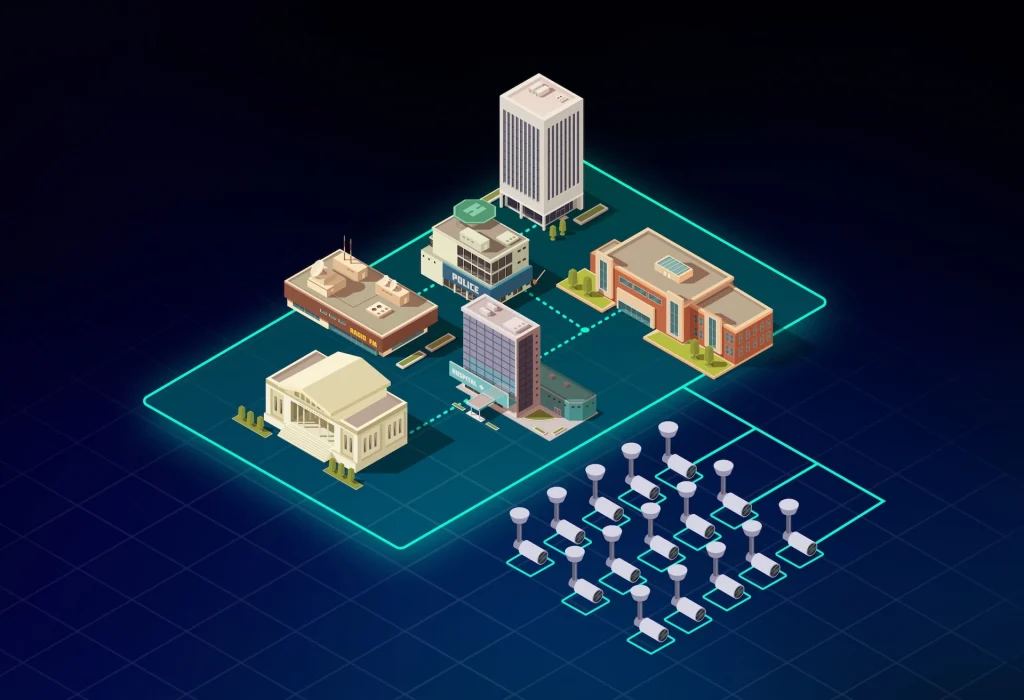Unlocking B2B Opportunities with Cloud-Based Video Surveillance VAS
Cloud video surveillance can serve as a valuable value-added service for telecom service providers. Cloud video surveillance for B2B telecom clients is an exceptional solution, allowing them to generate additional revenue streams. From an infrastructural perspective, VSaaS aligns well with the existing capabilities and assets of telecom companies. As it leverages their extensive network infrastructure, data centers, and cloud services. Telcos already possess robust connectivity solutions and secure data management systems, which are essential for reliable and efficient VSaaS delivery. Their existing infrastructure supports high data throughput and low latency, crucial for real-time video surveillance.
Furthermore, VSaaS complements the way Telcos do business. Telecom companies can seamlessly integrate VSaaS into their service offerings. It can help to enhance their value proposition, brand perception, market penetration and finally create new revenue streams.
It allows Telcos to diversify their revenue streams beyond core and other value-added services. As cloud is becoming mainstream, with the rise of smart homes and smart cities, VSaaS represents an opportunity for Telcos to capture a share of this emerging market.
One more advantage is that it’s an increasingly essential and suitable service for both residential (B2C) and business (B2B) customers. According to Aipix survey, the B2B segment continues to be a highly promising and advantageous avenue for telecom companies to provide digital VAS such as VSaaS, video analytics, smart intercoms and access control services. So in this article we’ll delve into the details of launching cloud video surveillance services to the B2B segment.
Best practices and prospects for telecom operators with provision of cloud video surveillance for B2B clients as a new VAS
By offering Video Surveillance as a Service (VSaaS), telecom operators can unlock numerous opportunities in the B2B market. They can generate recurring revenue through subscription models and enhance their service portfolio, making them more attractive to businesses. Utilizing their existing infrastructure, telecom operators can offer scalable solutions to a wide range of enterprises, from small businesses to large corporations. VSaaS enables cross-selling opportunities, sector expansion into various industries and the potential for data monetization through advanced analytics. This positions telecom operators as innovative leaders, fostering strong customer relationships and gaining a competitive edge.

Telecom Operators Targeting the SMB with VSaaS
Telecom operators can effectively target SMBs with VSaaS by offering cost-effective, scalable solutions that are easy to implement and maintain. By bundling VSaaS with other telecom services, providing advanced security features, and emphasizing remote monitoring capabilities to meet the specific needs of SMBs.
Small and medium-sized businesses (SMBs) often have limited resources and expertise when it comes to managing on-premises video surveillance systems. They face challenges such as upfront capital expenditures (CAPEX) for hardware and infrastructure, ongoing maintenance and upgrade costs, and a lack of in-house technical skills to operate and maintain a complex system.
VSaaS offers a compelling value proposition for SMBs, as it allows them to shift from CAPEX to predictable operational expenditures (OPEX), eliminate the need for onsite equipment and IT infrastructure, and receive a fully managed service, including planning, installation, and maintenance. Telecom providers can deliver cloud video surveillance services that meet SMB needs. They address customer issues from installation to technical support, offer flexible packages with customizable parameters, and simplify the service for SMBs.
Furthermore, Telecom operators can capitalize on SMBs’ desire to consolidate technology solutions and reduce vendor complexity by offering all-in-one service bundles, unified management platforms, and single points of contact by bundling VSaaS with their internet or other connectivity offerings.
Telecom VSaaS suits large, distributed enterprises
Large and distributed enterprises, with multiple locations and complex operational requirements, often face unique challenges that telecom providers can easily address.
One of the primary pain points for large enterprises is the need to manage and maintain video surveillance systems across numerous geographically dispersed sites. Traditional on-premises solutions can be cumbersome, requiring considerable resources for installation, configuration, and ongoing maintenance. This can be particularly problematic for enterprises with a global footprint or a rapidly expanding branch portfolio.
Telecom operators, with their extensive network infrastructure and data center capabilities, can offer a compelling VSaaS solution that addresses these challenges. By providing a centralized, cloud-based service, telecom providers can enable large enterprises to seamlessly manage their video surveillance systems from a single, unified interface, regardless of the number of locations or the physical distance between them.
Moreover, the scalability and flexibility inherent in a VSaaS model are highly valuable for large enterprises. As their business needs evolve and their physical presence expands or contracts, telecom operators can quickly and cost-effectively adjust the video surveillance infrastructure to match the enterprise’s changing requirements. This agility and responsiveness can be a significant competitive advantage for telecom providers in the B2B market.
In addition to the operational benefits, telecom operators can also offer large enterprises enhanced data analytics and business intelligence capabilities. By providing advanced cloud video analytic service, telecom providers can help these organizations derive deeper insights, optimize their operations, and improve decision-making processes.
By offering a comprehensive, integrated cloud service that is designed based on the best-in-class technology, Telcos can position themselves as trusted, end-to-end partners for large, distributed enterprises.
Pricing aspects of cloud video surveillance for B2B: what to consider?
As telecom operators seek to expand their offerings in the Video Surveillance as a Service (VSaaS) market, particularly targeting the B2B segment, a well-designed pricing structure is crucial for success. The core strategy for developing a cloud video surveillance service involves positioning the telecom operator as a comprehensive partner. This means going beyond merely selling or leasing cameras and offering access to specialized software. The operator takes on the entire project lifecycle: planning, project approval (if needed), installation, configuration, ongoing support, and adjustments. This holistic approach fosters long-term relationships with B2B clients, delivering high-value services that thoroughly address their business needs. Here’s a comprehensive approach that telecom providers can consider:
One-Time Payments
- Access to the Service. Telecom charges a one-time fee per camera for access to the cloud video surveillance service.
- Installation Fee. Telecom charges a one-time fee per camera, covering the costs of mounting, cabling, initial installation, and setup.
- Reinstallation Fee. If a camera needs to be reinstalled, telecom charges a one-time fee per camera for this service.
Monthly Subscription Fees
- Telecom charges basic monthly fee per camera based on the camera’s resolution (e.g. 2MP, 4MP, 8MP). This fee covers continuous access to the cloud service and standard support.
Extra fee consideration for providing cloud video surveillance for B2B customers
Furthermore, there are additional services available for an extra fee. These include an additional monthly fee per camera for extended video recording storage, based on the number of extra days the recordings need to be stored beyond the standard period. Customization of the user interface to meet specific business requirements is also offered at an additional fee. Designing and setting up video walls for enhanced monitoring capabilities can be availed for an extra charge.
In addition, when it comes to customers who already have video surveillance cameras installed, there is no one-time charge for camera installation, and a monthly subscription plan can be offered with a discount, for example 15-20%. This allows businesses with existing infrastructure to migrate to a cloud-based video surveillance service with minimal additional costs.
This pricing approach provides B2B customers with flexibility and transparency, allowing them to scale their video surveillance needs as their business grows. The one-time payments for access, installation, and setup ensure that the initial investment is clear, while the monthly subscription fees make the ongoing costs predictable and manageable.
The additional service offerings, such as advanced cloud video analytics , enable telecom operators to upsell and cross-sell, further enhancing the value for B2B customers.
How Telcos can choose the best digital platform for cloud VAS. Short guide
When selecting a software solution provider to power their cloud video surveillance (VSaaS) offering, telecom operators should consider the following important criterias:
Configurability for Subscribers. The software platform should allow the telecom operator to easily configure various video surveillance parameters on behalf of their subscribers. This includes creating user accounts, assigning permissions, defining camera layouts and video walls, adjusting video quality, configuring camera groups, and more. This enables the telecom operator to be solely responsible for the service operations without requiring extensive involvement from the subscriber.
Cost-Effective Performance. The acquisition and operation of equipment for receiving video data from cameras and storing video archives can represent a significant cost for the service provider. The software solution should offer high performance capabilities in order to minimize the capital and operational expenses incurred by the telecom operator. The more efficient the software, the lower the costs.
Scalability for Growth. The telecom operator must have the ability to quickly scale up their service capacity in the event of rapid growth in their subscriber base, without requiring major additional efforts. The software should be able to efficiently manage and allocate the necessary computational and storage resources to accommodate this scaling.
Integration aspects
Billing (BSS) Integration. The VSaaS service must be fully integrated with the telecom operator’s billing system. This includes support for various service statuses (start, stop, blocking, etc.) as well as the ability to configure and bill for different service parameters like camera resolution, archive depth, recording methods, and access to additional features.
Operational (OSS) Integration. The software platform should seamlessly integrate with the telecom operator’s customer relationship management (CRM) system as well as their equipment/inventory management systems. This enables smooth provisioning of the VSaaS service for new and existing customers.
Additional Integrations. The software may also offer the ability to integrate with other external systems, such as OAuth2 authentication, logging and analysis platforms, geographic mapping providers, and unified address systems for standardizing customer address data.
Final thought on cloud video surveillance provisioning for B2B telecom subscribers
Overall, when deciding on which software platform to choose for introducing cloud video surveillance (VSaaS) offerings to B2B, telecom operators and ISPs should carefully evaluate solutions that provide all of the above criteria.
Well, Aipix, being the telecom-centric platform, enables Telecoms and Service Providers to efficiently launch and manage an ecosystem of digital value-added services, with cloud video surveillance being a prime use case, and drive new revenue streams. Designed based on multi-tenancy, hybrid cloud approach, service auto-provisioning and API capabilities for full integration, the Aipix Telecom Platform provides telecom operators with a solution to expand their cloud services product portfolio for business customers, improve ARPU and increase NPS.
Ready to take your business to the next level? Let’s discuss how Aipix can help.





